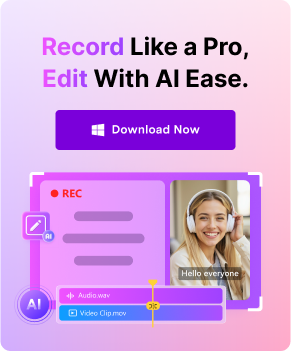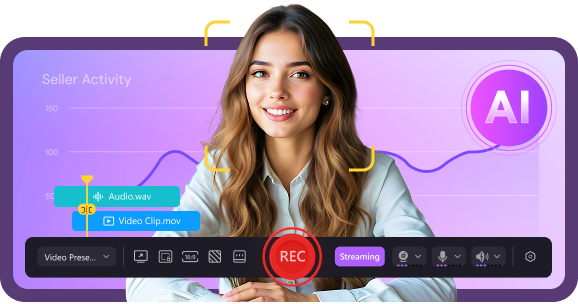Creating a successful podcast hinges on your ability to edit audio for a podcast effectively. This guide will empower you with essential editing techniques to enhance sound quality and engage your audience. With the powerful recording and editing features of Wondershare DemoCreator, you can streamline your production process and elevate your podcast to new heights. Let’s unlock your potential and make your voice heard!
In this article
Part 1: Understanding Audio Editing for Podcasts
Understanding audio editing is essential for podcast creators aiming to produce high-quality content. Audio editing in the context of podcasts refers to the process of refining raw audio recordings to enhance clarity, flow, and overall listener experience. To effectively edit audio for a podcast, creators must utilize various techniques that not only remove unwanted elements but also enrich the storytelling aspect of their episodes.

Importance of Audio Editing for Enhancing Podcast Quality:
Effective audio editing not only enhances the overall quality of your podcast but also plays a pivotal role in delivering an exceptional listening experience. Here are five key reasons why audio editing is essential for elevating your podcast:
- Improves Clarity: Editing helps eliminate background noise and distractions, ensuring that the main content is clear and easy to follow.
- Enhances Engagement: A well-edited podcast keeps listeners interested by maintaining a smooth flow and pacing, which is crucial for retaining audience attention.
- Professionalism: High-quality audio editing projects a professional image, building trust and credibility with your audience.
- Creative Storytelling: Editing allows for rearranging segments to create a compelling narrative, enhancing the overall storytelling experience.
- Consistency: Regular editing ensures uniform sound quality across episodes, reinforcing brand identity and listener loyalty.
Part 2: Why Audio Editing is Essential for Podcasts
Audio editing is a fundamental aspect of podcast production that significantly impacts the quality and professionalism of the final product. By refining raw audio, editors enhance clarity, remove distractions, and create a seamless listening experience. In today's competitive podcast landscape, the ability to edit audio for a podcast is essential for engaging audiences and establishing credibility.
Benefits of Editing Audio for Podcasts:
Here are five key benefits of editing audio for podcasts:
- Enhanced Sound Quality: Professional editing helps eliminate background noise and adjust volume levels, resulting in clearer and more balanced audio that is pleasant to listen to.
- Increased Listener Retention: Well-edited episodes maintain a steady pace and eliminate filler content, making it easier for listeners to stay engaged throughout the entire episode.
- Enhanced Emotional Impact: Thoughtful editing can heighten the emotional resonance of your content by emphasizing key moments, pauses, and transitions, allowing listeners to connect more deeply with the material.
- Flexibility in Content Creation: Editing allows podcasters to experiment with different formats and styles, enabling them to refine their approach based on audience feedback and preferences.
- Time Efficiency: Outsourcing audio editing allows creators to focus on content development and marketing while ensuring timely episode releases, saving valuable time in the production process.
Part 3: Tools for Editing Podcast Audio
Editing podcast audio is a crucial step in producing high-quality content that resonates with listeners. Utilizing the right tools can make this process more efficient and effective, allowing creators to focus on delivering engaging stories. Whether you're a beginner or a seasoned podcaster, having access to reliable software is essential. Here are five top online podcast editor tools that can help you edit audio for a podcast, enhance your audio quality, and streamline your editing process:
1. Reaper
Reaper is a powerful digital audio workstation (DAW) developed by Cockos and is known for its flexibility and extensive features. It allows users to record, edit, and produce audio and MIDI with ease, making it suitable for both beginners and experienced professionals. Reaper's nondestructive editing capabilities mean that any changes can be undone, offering a safe environment for experimentation. Additionally, it supports a wide range of plugins and customization options, catering to various audio production needs.

Key Features:
- Reaper offers multitrack recording, enabling users to layer multiple audio sources seamlessly for complex compositions.
- The software includes a comprehensive set of built-in effects and plugins, such as EQ, reverb, and compression tools, enhancing audio quality without needing third-party software.
- Users can customize the interface extensively, allowing them to create personalized workflows that suit their editing styles.
- Reaper supports a variety of audio formats and can import/export files easily, making collaboration with other software straightforward.
- The software's routing capabilities are highly flexible, allowing for intricate signal paths and effects processing across multiple tracks.
Step-by-Step Guide:
Step 1Setting Up Your Project:
Begin by launching Reaper and creating a new project. Import your audio files using the drag-and-drop interface or the file menu to start your editing process.
Step 2Editing Your Audio:
Use the timeline to arrange and edit your audio tracks. Utilize tools such as cut, copy, paste, and trim to refine your recordings. Apply effects and adjust levels using the built-in plugins to enhance sound quality.
Step 3Exporting Your Final Mix:
Once you are satisfied with your edits, go to the File menu and select "Render." Choose your desired format and quality settings, then export your final mix for distribution or sharing.
2. Soundtrap
Soundtrap is a versatile, cloud-based audio editing platform that caters to both beginners and experienced podcasters. It enables you to record, enhance, and edit audio for a podcast with ease, offering a seamless user experience. Designed for collaboration, it allows multiple users to work on the same project in real time. Whether you're at home or on the go, Soundtrap makes it simple to edit audio for a podcast and create professional-quality episodes.

Key Features:
- Multi-track recording allows users to layer and manage multiple audio tracks, making podcast editing seamless and efficient.
- A wide range of built-in effects, such as equalization, reverb, and noise reduction, ensures polished and high-quality audio.
- Collaboration tools enable creators to invite team members and work on the same project simultaneously, regardless of location.
- Automatic cloud saves provide secure storage and easy access to your projects from any device, ensuring work is never lost.
- Cross-platform compatibility means you can edit audio for a podcast on your computer, tablet, or smartphone without missing a beat.
Step-by-Step Guide:
Step 1Setting Up Your Project:
Sign up or log in to your Soundtrap account and select the podcast template to start. Name your project and choose your preferred audio settings for recording and editing.
Step 2Recording and Editing:
Record audio directly using Soundtrap’s tools or upload pre-recorded files. Edit audio for a podcast by trimming, rearranging clips, and applying effects like noise reduction and equalization to enhance quality.
Step 3Exporting and Sharing:
After finalizing your edits, export the podcast in your desired format. Use Soundtrap’s sharing and distribution features to publish your episode or share it with collaborators.
3. Riverside
Riverside is a versatile recording and editing platform designed for creators who demand professional-grade audio and video quality. While widely used by podcasters, it also serves content creators, educators, and businesses looking for reliable tools to capture and edit audio for a podcast or other projects. Its local recording feature ensures pristine quality, and its intuitive interface makes editing simple and accessible, even for beginners.

Key Features:
- Local recording captures high-quality audio and video directly from participants' devices, ensuring clarity and consistency.
- An easy-to-use editor allows users to trim and arrange clips without requiring advanced technical skills.
- Automated transcription creates text versions of your recordings for captions, blogs, or searchable archives.
- Multi-track recording provides separate files for each participant, giving more control over the final mix.
- Audience engagement tools, such as call-ins and live streaming, help you connect with your listeners in real-time.
Step-by-Step Guide:
Step 1Create and Customize Your Session:
Sign in to Riverside and set up a new recording session. Adjust audio and video settings based on your project needs and share the session link with participants to join remotely.
Step 2Record and Fine-Tune Your Audio:
Begin recording your content using Riverside's local recording feature. After recording, access the built-in editor to trim, rearrange, and refine your audio to ensure a polished result.
Step 3Export and Finalize Your Podcast:
Export your project in high-quality audio or video formats. Use the transcription tool to create accompanying text files, and distribute your podcast or content through your preferred channels.
4. Podcastle
Podcastle is an all-in-one platform designed to make podcast recording, editing, and publishing as simple as possible. Offering a browser-based interface, it enables creators to record high-quality audio and video remotely with ease. Podcastle's advanced editing tools allow you to edit audio for a podcast with precision, while its user-friendly features make it ideal for both novice and seasoned podcasters. Whether you’re editing solo or collaborating, Podcastle helps streamline your podcast production.

Key Features:
- High-quality browser recording enables users to capture professional-grade audio without the need for external software or equipment.
- AI-enhanced noise reduction automatically removes background noise, enhancing the overall clarity of your recordings.
- Multi-guest recording allows you to record high-quality audio for multiple participants simultaneously, regardless of location.
- Clip editing tools let you quickly cut, trim, and rearrange segments to streamline the editing process and perfect your podcast.
- Integrated publishing tools allow for effortless distribution to popular platforms such as Spotify, Apple Podcasts, and Google Podcasts with one click.
Step-by-Step Guide:
Step 1Create Your Project and Invite Guests:
Log in to Podcastle and create a new project. Share the session link with your guests, and set the desired recording settings.
Step 2Record and Edit Audio:
Begin recording with Podcastle’s browser-based tool, capturing high-quality audio. After recording, use the editor to trim, remove noise, and improve audio levels.
Step 3Export and Distribute:
Once your podcast is edited, export the file in your preferred format. Use Podcastle's one-click publishing feature to distribute it across major podcast platforms.
5. Auphonic
Auphonic is an online audio processing platform designed to help creators enhance and refine their audio recordings. Known for its user-friendly interface, it automatically optimizes audio quality with a range of advanced features, making it ideal for both beginners and professionals. Its powerful tools focus on improving loudness, reducing background noise, and ensuring consistent sound levels across different recordings. Whether you're a podcaster, musician, or broadcaster, it provides an efficient way to polish your audio and deliver a professional listening experience.

Key Features:
- Automatic audio leveling ensures that the volume levels are consistent throughout the recording, removing discrepancies between different speakers.
- Noise and hum reduction uses advanced algorithms to remove unwanted noise and background hum, improving the overall clarity of the recording.
- Multi-format export allows you to process audio and export it in various formats, including MP3, AAC, and WAV, based on your needs.
- Speech enhancement improves voice clarity, making speech more intelligible, particularly in noisy environments or for recordings with heavy accents.
- Batch processing enables users to process multiple files at once, saving time and streamlining the editing workflow for large projects.
Step-by-Step Guide:
Step 1Upload Your Audio:
Sign up or log in to Auphonic, then upload your audio file. Select the desired settings, such as input type, format, and preferred output.
Step 2Process and Enhance Your Audio:
Choose the desired processing options, including noise reduction, leveling, and speech enhancement. Auphonic will automatically apply these adjustments to optimize the sound quality.
Step 3Download and Use Your Processed File:
Once the audio processing is complete, download the enhanced file in your preferred format. You can now use it for distribution or further editing as needed.
Part 4: Tips for Effective Podcast Audio Editing
Achieving high-quality audio in your podcast is essential for captivating your audience and delivering a professional sound. By following effective editing practices, you can improve the clarity and flow of your episodes while making the editing process more efficient. Here are five valuable tips to help you edit audio for a podcast effectively:
- Record in a Quiet Environment: Ensure that you record in a space free from distractions and background noise. This will minimize the amount of editing needed later and improve the overall audio quality.
- Batch Process Your Edits: Use automation options within the best podcast editor tools to apply noise reduction and normalization across multiple audio files at once. This saves time and maintains consistency in sound quality throughout your episodes.
- Focus on Major Cuts: Instead of obsessively removing every "um" or pause, concentrate on cutting larger sections that do not contribute to the conversation. This approach results in smoother edits and a more natural flow.
- Use Templates for Consistency: Create templates for recurring elements like intros, outros, and ads. This allows you to maintain a consistent style across episodes while saving time during the editing process.
- Review and Fine-tune: After editing, listen through the entire episode to ensure everything flows well. Make any necessary adjustments to timing or sound levels for a polished final product.
Bonus Tool: Use Wondershare DemoCreator for recording and editing podcasts
Wondershare DemoCreator is a powerful and versatile tool that blends high-quality screen recording with intuitive video and audio editing features. Designed for creators of all types, DemoCreator is particularly well-suited for podcasters, offering excellent tools for podcast video editing and the ability to edit audio for a podcast with ease. The software’s seamless interface allows you to record and refine both audio and video content, add real-time effects to enhance quality, and effortlessly export your creations in multiple formats. Whether you're integrating visuals into your podcasts or focusing solely on audio clarity, it equips you with everything needed to produce professional-grade content in less time.

Key Features:
- Multi-track Editing: Easily edit and mix multiple audio tracks, perfect for podcasts with several participants or layered sound effects.
- Screen and Audio Recording: Record high-quality screen captures and audio simultaneously, ideal for creating video podcasts or instructional content.
- Voice-over Recording: Effortlessly add voice-overs to your podcast episodes, allowing for clear and timely narration integration with your recordings.
- Real-time Audio Effects: Apply noise reduction, equalization, and volume leveling effects during the editing process to ensure crystal-clear audio quality.
- Export in Multiple Formats: With support for a variety of file formats, DemoCreator ensures your podcasts and videos are compatible with all major platforms and podcast directories.
Step-by-step guide:
Step 1Import Media into the Timeline
To start editing, launch Wondershare DemoCreator and select the ‘Video Editor’ option. Begin by importing your media using the ‘Import Media’ option. Once the media file is imported, drag it onto the timeline to prepare it for editing.

Step 2Apply Audio Enhancements
Next, navigate to the Audio Effects tab on the left panel, where you will find several audio enhancement options, including AI Voice Cleaner, AI Denoiser, AI Voice Changer, AI Vocal Remover, and Voice Effects. Experiment with these tools to enhance your audio and add a unique touch to your video. On the right panel, select the Audio option to adjust the volume, add fade-in or fade-out effects, and refine the sound. Customize the video’s audio settings as needed to achieve outstanding results. Also, on the left panel, you would find an option for video effects, by clicking which you would be able to enhance the video of your podcast, along with magic tools on the right panel, which can do wonders on your video.

Step 3Export Your Video
Once the editing is complete, click on the Export button located in the top-right corner of the screen. In the export dialogue box, choose the desired aspect ratio, resolution, and output location for your video. Finally, click on the Export button in the bottom-right corner to save your edited video.

Conclusion
In today’s competitive podcasting landscape, effective audio editing is crucial for creating content that captures and maintains the listener's attention. Using powerful tools and techniques to edit audio for a podcast not only improves sound quality but also enhances the overall listener experience. Wondershare DemoCreator stands out as a game-changer, offering an exceptional platform for recording and editing podcasts with ease and precision. Its advanced features streamline the entire production process, helping podcasters deliver professional-quality content effortlessly. Ready to elevate your podcast? Start using Wondershare DemoCreator today and transform your podcasting journey!
FAQ
-
Q1. What is the best software for editing podcast audio?
The best software for editing podcast audio depends on your needs, but Wondershare DemoCreator stands out for its user-friendly interface, multi-track editing, and real-time audio effects. It simplifies the editing process while offering powerful features, making it ideal for both beginners and professionals. -
Q2. How can I improve my podcast's sound quality?
To improve your podcast’s sound quality, focus on using a high-quality microphone, recording in a quiet space, and eliminating unwanted noises during editing. Enhancing volume consistency and applying equalization can also help boost clarity. -
Q3. What features should I look for in podcast editing software?
When choosing podcast editing software, look for multi-track editing, noise reduction, volume leveling, and export options for different formats. Features like voice-over integration and real-time audio effects can also be helpful for creating polished content. -
Q4. Can I use Wondershare DemoCreator for video podcasts?
Yes, Wondershare DemoCreator is perfect for video podcasts. It allows you to record both audio and video, edit them together, and apply effects to enhance the overall quality, making it an excellent tool for podcasters looking to incorporate visuals. -
Q5. How do I remove background noise from my podcast recordings?
To remove background noise from your podcast recordings, use noise reduction features in editing tools like Reaper or Auphonic. Both offer automatic noise filtering that helps eliminate unwanted sounds like hums, hisses, or static, ensuring your audio remains clear and professional.



